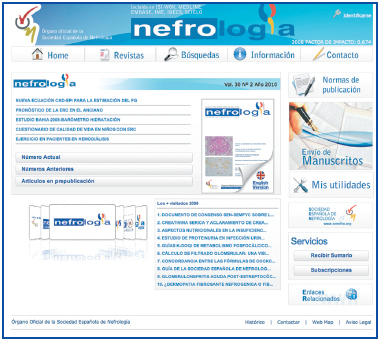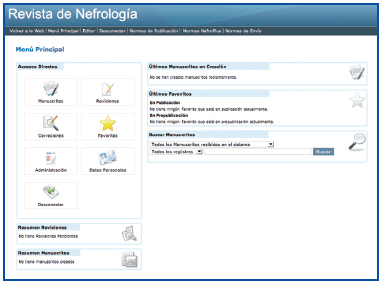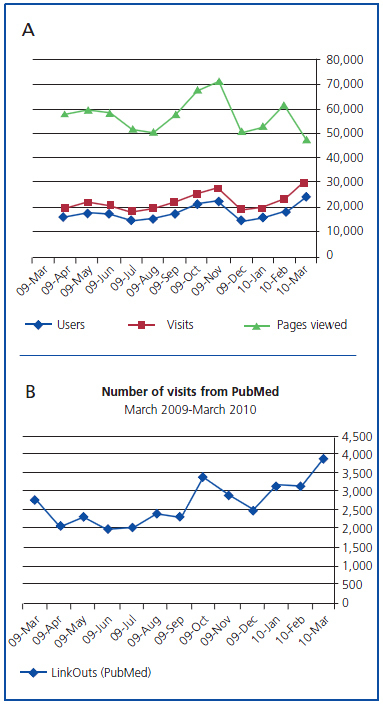In March 2010, the website for the NEFROLOGIA Editorial Group (www.revistanefrologia.com) was upgraded. This is a new application that aims to enhance the interactivity of the electronic version of the journals of the Spanish Society of Nephrology (SEN) and provide greater technological capabilities that enable successful handling of the Editorial Group’s new projects. This “Editorial” highlights the importance of new technologies in the dissemination of biomedical information and details the changes that the new website currently incorporates as well as those that will be implemented in the coming months.
IMPORTANCE OF WEB DISTRIBUTION OF BIOMEDICAL JOURNALS
The emergence of the Internet and the development of new information technologies have revolutionised all stages of scientific communication. Biomedical journals are no exception and to a greater or lesser extent they have been adapting to the new requirements of a society in which, in only a few years, globalisation has shattered the boundaries of communication and has put the health professional into a situation of information overload. The traditional printed scientific journal is no longer the main element of continuing medical education and it had to be incorporated into the digital world through tools that allow it to provide quality information in a friendly electronic environment, one that ensures appropriate distribution in an increasingly competitive environment to potential readers who are increasingly becoming overloaded with information.
This transformation in such a short a period of time has led to a change in the traditional flow of communication for scientific information (editing, reviewing, publication of an issue of the journal, indexing and distribution). Electronic publishing allows for streamlining the entire process, which is triggered when a work is received, significantly optimising the review process and allowing for essentially instant indexing in PubMed and other databases, along with electronic distribution, upon approval of the work.1 Article management and publication “ahead of print”, facilitated by the use of electronic tools and assignment of unambiguous identifiers through the DOI (Digital Object Finder) system, has made it possible to greatly reduce publishing times and encourages the exchange of ideas and scientific progress.2
In recent years, biomedical journal websites have ceased to be a structured collection of documents in electronic formats accessible via the World Wide Web (known as Web 1.0) to become truly interactive platforms that facilitate information exchange and interoperability through a usercentred design. These websites, known as Web 2.0, offer, in the case of electronic journals, additional services such as the possibility of commenting on published papers, quickly forwarding them by email, RSS (Really Simple Syndication) that allows rapid distribution of news that appears on the site, “blogs” for describing new trends, “Wikis” for sharing knowledge, and audio and video “podcasts” as a continuing education tool and for debate on current issues.3 Several recent publications have analysed the impact of these new electronic services in medical training and practice.4,5 The trend for the coming years is what is known as Web 3.0 or “semantic Web”, which is based on the transformation of the Web into a database for manipulating data more efficiently and personalising access to updated and instant information.6
So many changes in such a short time make it difficult for publishers and users to adapt without suffering stress and tie-ups. Maintaining a printed journal, with its high printing and distribution costs, along with its electronic version becomes increasingly complex with more services and more costs (computer application design, maintenance, server hosting). In addition, a declining funding framework from the pharmaceutical industry has caused many important journals to opt for reducing the number of articles in the printed edition and shorter in length than the one that appears on the website, which on the other hand, is the most read by the end user.7 The funding problem is even greater for those journals that are not backed by scientific institutions or societies, since they have seen greatly reduced their direct revenues from subscriptions given the wide accessibility and dissemination of the electronic version of published articles and the growing use of electronic platforms that collect freely available articles such as PubMed Central (http://www.ncbi.nlm.nih.gov/pmc/) and sCieLO (http://www.scielo.org), among others. Another aspect of the debate in this context of electronic dissemination of information is the utility of currently used bibliometric indices such as the Impact Factor. New emerging indices such as Eigenfactor (www.eigenfactor.org) could be more appropriate for measuring the actual influence of a journal in the scientific community.8
NEW WEBSITE FOR THE NEFROLOGIA EDITORIAL GROUP
With the aim of progressively improving the administrative and bibliographic functions of the NEFROLOGIA editorial group and of progressively incorporating utilities that improve the presentation and dissemination of the different SEN journals, the website has been completely remodelled (www.revistanefrologia.com) (Figures 1 and 2). The major changes in the website are:
1. Integration of all NEFROLOGIA editorial group’s productions on the same site and in the same format, including: NEFROLOGIA, NEFROPLUS, NEFROLOGIA BASADA EN LA EVIDENCIA, supplements in NEFROLOGIA and Monographs.
2. Free access to the entire NEFROLOGIA archive from the first issue of 1981 to the present.
3. Presentations in text and PDF formats of every article in a much more attractive fashion than the previous website with additional services that improve user interactivity such as the ability to comment on each published work, instant access to the access statistics of each article and access to related works both on PubMed and NEFROLOGIA.
4. Personal space for each registered user on the website that lets them customise a collection of favourite articles of NEFROLOGIA Editorial Group (Figure 2).
5. Improvements in the presentation and functionality of all tasks related to introduction, peer review and editing of originals.
6. Questionnaires for online evaluation of journals such as NEFROPLUS and selected monographs that have continuing medical education credits.
7. Improved search engine.
8. Coming soon, the ability to send via email any article that appears on the website and the addition of RSS feeds to receive all updates that appear on the site.
The website platform is aimed at management by article, not by journal issue, so that, after approval of each original, its corresponding DOI is created automatically and the process of editing, layout and indexing in PubMed are initiated, which allows it to be included in the website and on PubMed as an article in prepublication one or two months in advance of the distribution of the print edition. This system also includes the possibility of adding supplementary information that will not appear in the print edition in all articles.
The generation of messages to the NEFROLOGIA mailing list (lista-nefrologia@senefro.org) has been automated as well as the inclusion of each number in sCieLO (www.scielo.org), Scientific Electronic Library Online for Latin America that since the end of 2009 collects the complete texts of the scientific production of NEFROLOGIA.
These strategies, already underway in recent months, aim towards improving visibility and dissemination of NEFROLOGIA especially in the English-speaking world. The visitor statistics for our articles on PubMed seem to support this idea (Figure 3). According to this agency’s report, the articles of NEFROLOGIA were consulted by an average of 1,757 visits per month in the last half of 2007. This number has grown steadily with 3,686 visits in March of 2010 (last available data) the highest number achieved by our journal in PubMed so far.
FUTURE PROJECTS: NEFROLOGIA IN A DIGITAL FORMAT
The future of biomedical journals is based on enhancing the possibilities offered by new information technologies. While not neglecting the quality of the print edition, SEN publications, included under the umbrella of NEFROLOGIA Editorial Group as the coordinator of all publishing activity of our scientific society, must have the broadest dissemination and visibility possible through the website, so as to empower one of our main strengths: our standing as the leading nephrology journal in Spanish and reference for all of Latin America. To do this, we must not only insist on a greater presence in the main bibliographic databases such as PubMed, in which access to all the articles of NEFROLOGIA has been consolidated, but also advance the inclusion in biomedical literature databases that include full text articles such as PubMed Central (http://www.ncbi.nlm.nih.gov/pmc/). The development of an English version of the current website will provide greater visibility for our journal in English speaking countries.
The dissemination of activities of NEFROLOGIA Editorial Group through the website is another objective that should be strengthened in the medium term. As a Web 2.0 site, it should enhance the user interaction. Therefore, the index numbers of the various journals are sent by e-mail as soon as they are available on the website. In the case of NEFROLOGIA, this index is disseminated in English to a significant number of ERA-EDTA members. Nevertheless, we are aware that much of SEN’s publishing activity through its website (www.senefro.org), its journals and its various workgroups does not have adequate dissemination. To correct this, the NEFROLOGIA DIGITAL project has been put in motion with the primary objective of using new information technologies to increase the efficiency and visibility of the knowledge transfer programs and continuing education courses of SEN and NEFROLOGIA Editorial Group. The main tasks that this project will develop are:
1. Enhance communication through the mailing list (listanefrologia@ senefro.org) of the main editorial news of Editorial Group.
2. Disseminate specific aspects of SEN’s publishing activity through a specific web environment included in the editorial group website. These include articles of interest from various journals, case reports, images of interest, “Ask the Expert” questions, and SEN web conferences, among others. These aspects will be disseminated in structured newsletters that will also be sent through the email mailing list.
3. Incorporate digital books into the NEFROLOGIA website in a format that allows for continuous updating of contents by authors and editors.
4. Post educational material to the website that is not published in print editions of the journals.
To meet these goals, along with the rest of the commitments that current technology and globalisation of biomedical information access demands, everyone’s effort is required: the SEN Board of Directors, the members of editorial group and, above all, the SEN members so as to maintain their trust and their continued citation and submission of their scientific work to NEFROLOGIA and to the rest of the editorial group journals. Without this scientific production of increasing quality, the rest is merely a wrapper, an elaborate and attractive one, but a wrapper nonetheless.
Figure 1. Front page of the NEFROLOGIA website.
Figure 2. Individual utilities offered by the website to registered users.
Figure 3. Last year¿s (March 2009 to March 2010) access statistics for NEFROLOGIA. A: Visits to the NEFROLOGIA website. Source: Google Analytics. B: visits to the NEFROLOGIA website from the PubMed database. Source: PubMed.












